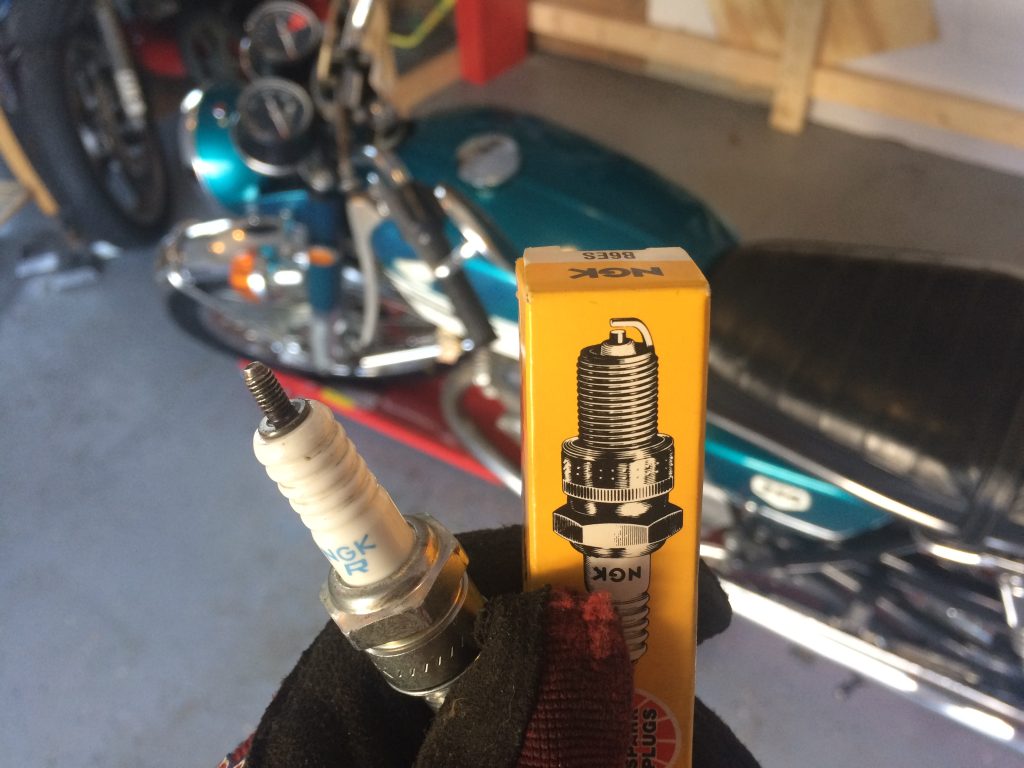
While we’ve covered resistance in spark plug wires before, the opportunity recently arose to talk about resistance in spark plugs and plug boots too.
You may have read the earlier article on my star-crossed 1970 Honda CB350’s fuel delivery woes. Truth is, fuel was only part of the story. There were some topics on spark that warranted a standalone article.
In the name of brevity, we’ll skip the electrical theory on the role resistance plays in an ignition system (though Hemming’s has a great article on it here).
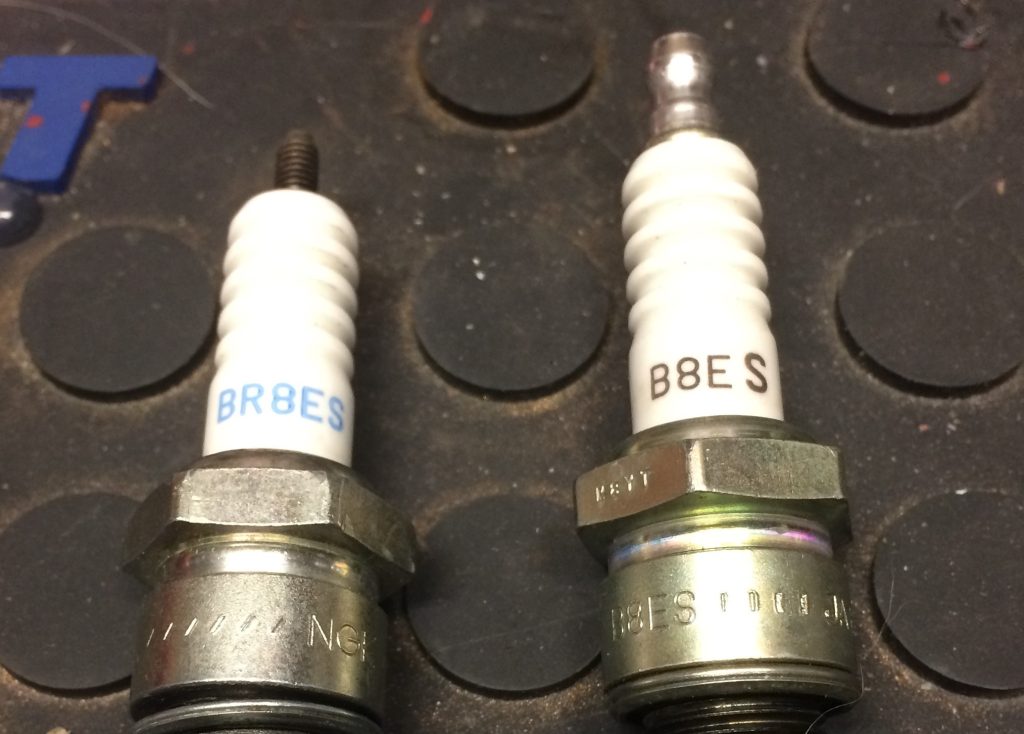
Resistance Built-In to Modern Spark Plugs
It all started when trying to buy new spark plugs for that aforementioned CB. Figuring it was best to start fresh with new plugs, I dove into my ancient Honda shop manual, which said the bike requires NGK B8ES spark plugs—a very common plug at the time. (Two were also already in the bike when I began its restoration.) Nowadays though, that particular spark plug has been superseded by the NGK BR8ES.
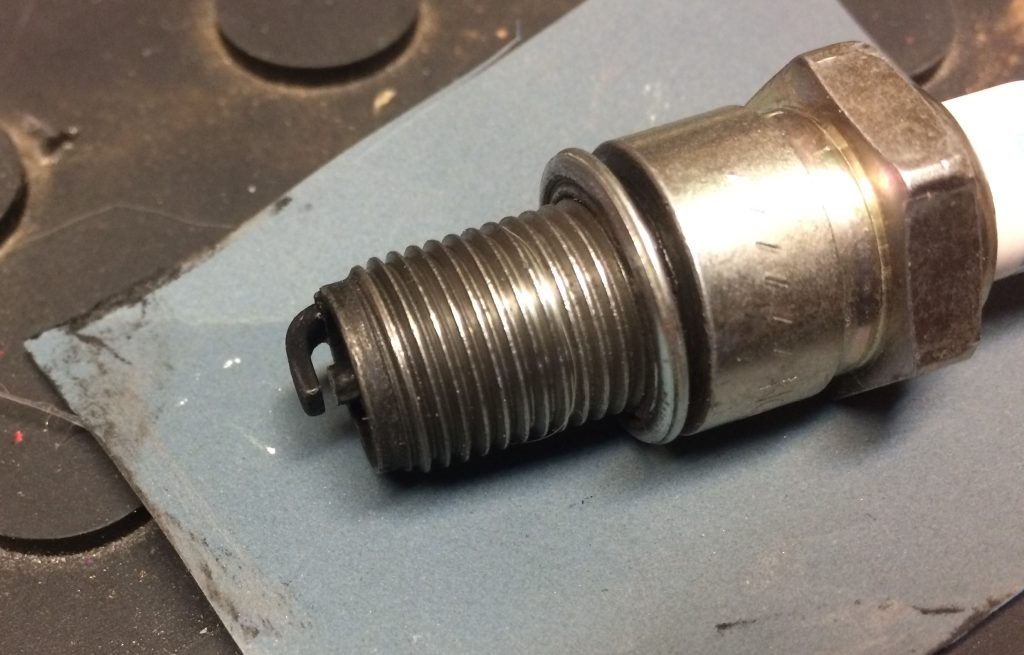
But in the case of the NGK B8RES, the R means that it’s got a 5,000 Ohm (or 5 kiloohm/5 kΩ) resistor built in. The job of that integrated resistor is to reduce electromagnetic interference (electrical noise) stemming from spark discharge that could impact electronic systems like a vehicle’s radio or, more importantly, its ECU.
Resistance is measured in Ohms, represented by the “Ω” Omega symbol—just ask Charlton Heston.
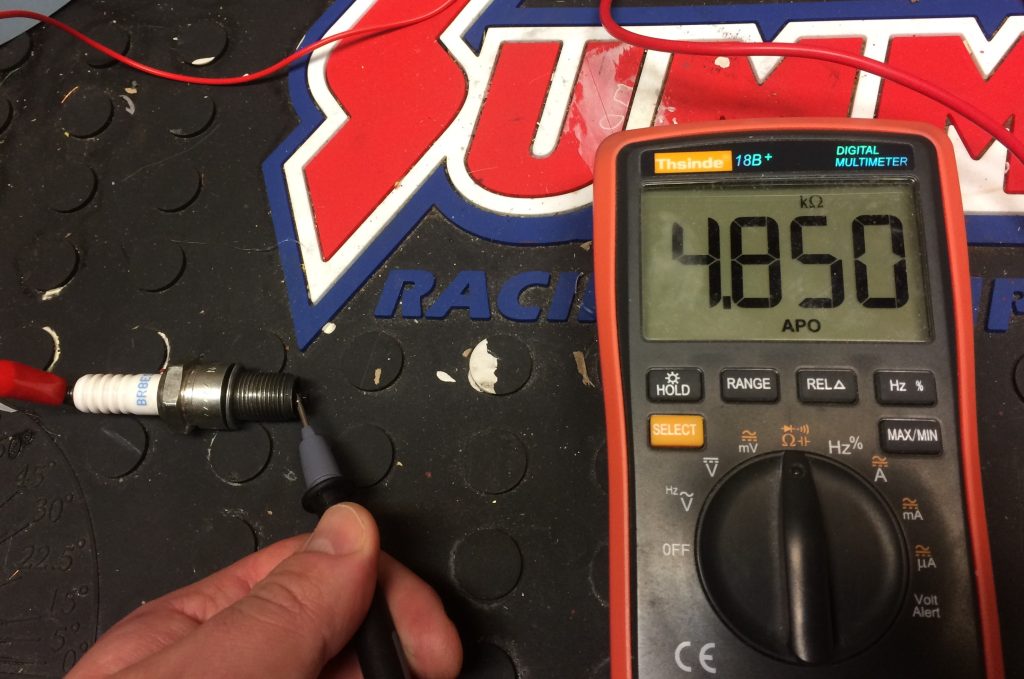
Resistance-type spark plugs are quite common these days and for a large spectrum of engine applications, they’re perfectly fine. More importantly, for vehicles that do have those high-tech electronic systems, they can be downright essential.
Problem is, that extra resistance can also affect things like spark duration and intensity—which for a small carbureted twin-cylinder engine that demands precision ignition timing, could potentially hinder the way it runs. And since there’s no radio or ECU to worry about in a 50-year-old motorcycle, I simply cleaned and re-used the old, non-resistor NGK B8ES plugs I had in there originally. (The goal here was to return the bike to as close to showroom-spec as possible.)
Yet the spark plug thing was only part of the story.
Resistance In the Spark Plug Boot
For a lot of vintage motorcycle engines, the ignition coil has an integrated spark plug wire. You simply add the correct spark plug boot for your motor’s application. In the case of the Honda, it required a right angle boot with 5K ohms of resistance.
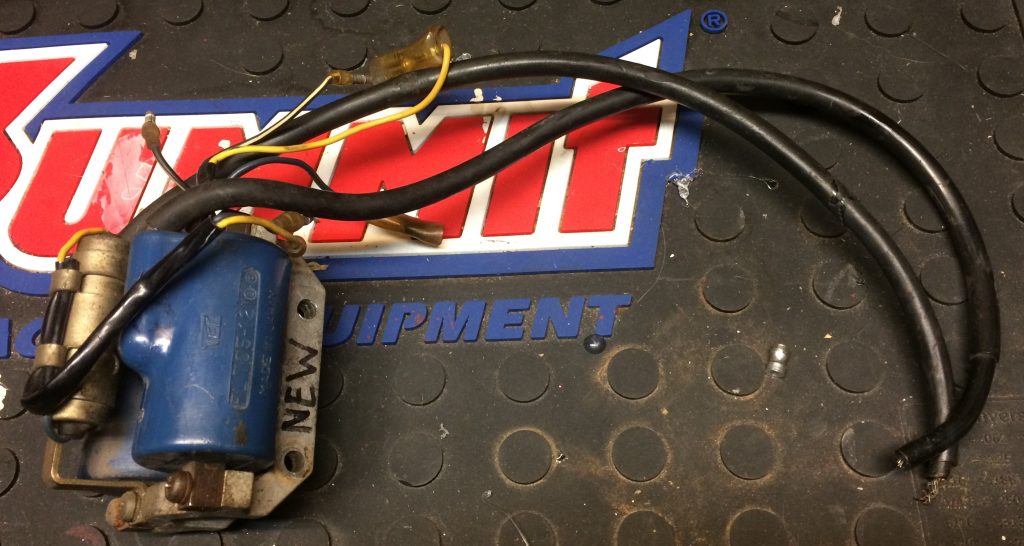
Easy enough—while I was resurrecting the little Honda, I replaced the coils, but planned on merely swapping the old, original plug boots onto the new ignition wire ends. No need to worry about using the wrong boot there.
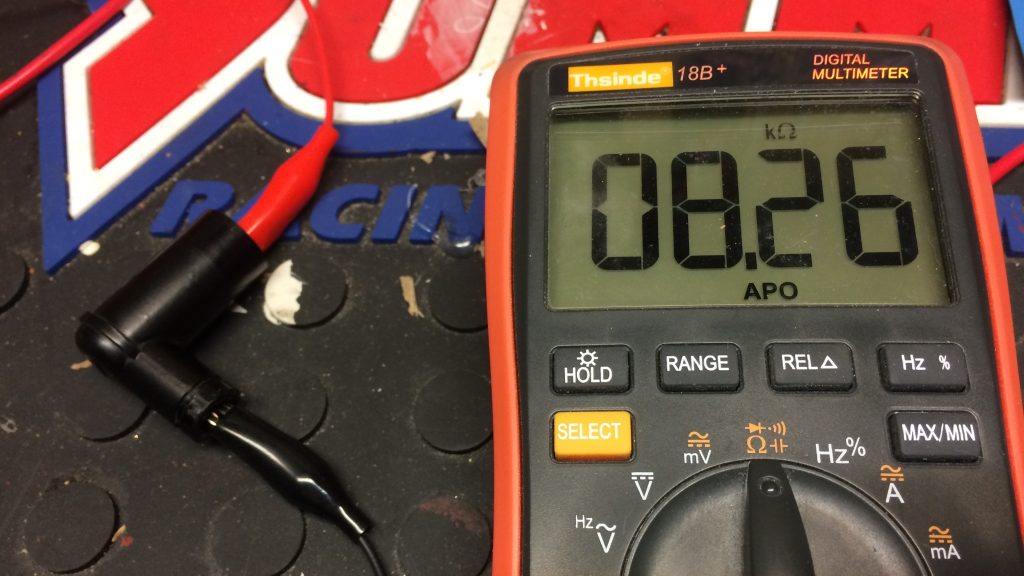
But as anyone who works around old electronics already knows, resistors can drift off-spec with age. In my experience, it often means the resistor will gradually increase its resistance, until it ultimately fails open and you get a complete break in continuity. (In fact, we saw this with an old blower motor resistor a little while ago.)
So to get the bike to run smoothly, I checked everything first, including the spark plug boots. That’s when I found that, instead of the stock 5,000 ohms, they both were reading significantly higher, closer to 8 kΩ.
A new set of plug boots was ordered shortly thereafter.
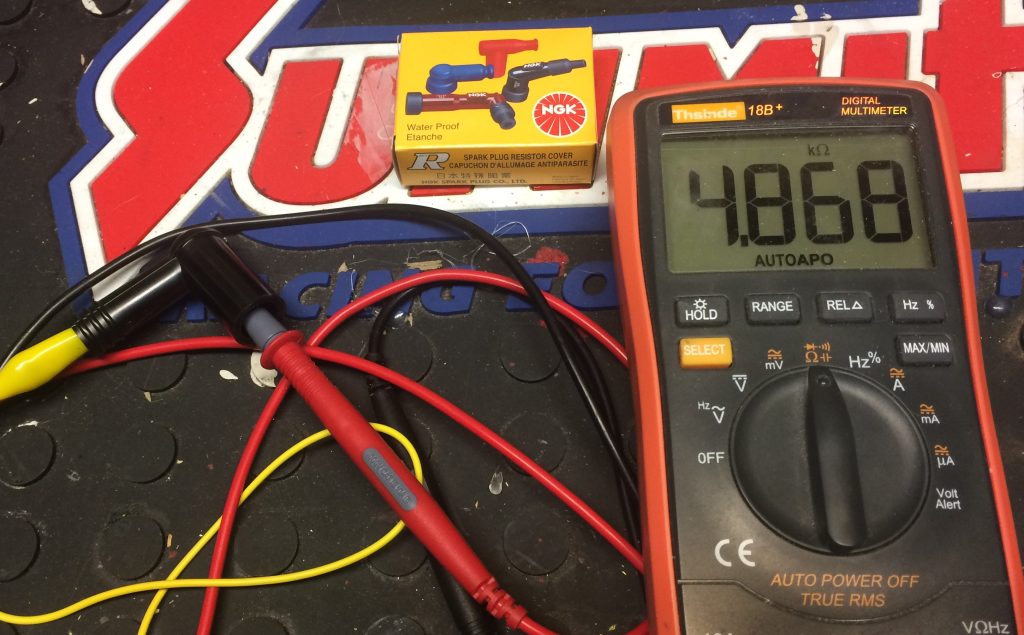
Joining the Resistance
Remember, from the factory, the little Honda’s ignition system wanted to see around 5 kΩ at the spark plug electrode.
But electrically speaking, resistance values are additive when wired in series. That means that the overall resistance is equal to all the resistors in-line in the circuit. So, by using the new NGK BR8ES, it essentially added 5,000 ohms to the mix.
And when coupled with the old OE spark plug boots that were testing much higher than stock, the resistance increases even more. So, all together now:
5 kΩ plug + 8 kΩ boot = 13 kΩ total
While I’m by no means a math expert, I do know that 13K =/= 5K.
Being 8,000 ohms out-of-spec could have had an effect on spark delivery, which may result in potential performance issues.
So again, I wanted this bike to be showroom fresh. That meant running the proper 5K ohm spark plug boots with a cleaned up set of old zero-resistance NGK B8ES spark plugs. All told, with this ignition setup and the resolved fuel issue outlined in that earlier article, the Honda got a new lease on life.

As a footnote, I was a tad concerned about the dwindling supply of NOS NGK B8ES spark plugs out there. But the good news, is that you can simply move the resistance around. In other words, I’m optimistic that the new NGK BR8ES with 5 kΩ of resistance will work perfectly fine in this application, provided they’re paired with zero-resistance spark plug boots.
Regardless of how the plug- and boot-swapping game plays out, the moral of the story here is to always ensure that your ignition resistance numbers are inline with the factory specs—provided you’re running the stock setup anyway.
Aftermarket performance ignition systems are far more nuanced, but that’s a topic for a different day…

There is no reason to run resistor spark plugs or resitor wires other than to eliminate RFI (radio frequency interference). RFI is not a problem if you do not have a radio in/on your vehicle. It may cause some minor problems with police radios.
Hi, I’ve never heard of spark plug boot resistance. I’m not saying that it’s not real, but I’ve never heard pof it and I’ve been following motors and vehicles for 50 plus years. I will say that I’m not sure how it would impact things. The boot would NOT be in series with the plug wire. If it made contact with the top of the plug and some metal part of the engine, it would show up as a parallel resistance. Why that would be desirable is beyond me — unless it’s supposed to minimize electrical noise from the spark plug. The only important connection for that would be between the boot and a metal part of the engine.
Maye there’s another explanation, but I have no idea what that might e.
As far as resistance and the spark — it doesn’t seem to be that much of an issue. In the 60’s they had something called series gap plugs that were supposed to provide better ignition. They actually had a gap inside the plug as well I guess — read about them in some Smokey Yunick articles years ago — they don’t even show up on google anymore. But anyway, you would think that they would reduce the spark, but I guess that they didn’t.
Enjoyed the article, but I’m not sure that the boot resistance theory is presented correctly — but I’m more than willing to be proven wrongh.
Hey Harry, thanks for reading—check out Russell’s response below. Perhaps it was a strictly Honda thing? Glad you enjoyed the article.
I cannot speak to all old bike, but old Honda’s from the 60’s and 70’s had resistor spark plug caps. I ran into the same issue that the poster of this article did. I was restoring a 1972 Honda CB500, and it was giving me headaches becuase it was missing. On the Honda forum I joined, there was a 40+ year Honda mechanic that informed me to look at the resistance on the spark plug caps. The original ones for the CB500 were 7.5k, there was one that was close but the other ones had more than double or more of stated resistance. NGK sells the replacement resistor hard plastic caps that have I think 5 or 10K ohm options. Changed the caps, and restriped the wire insulation to expose clean wire, and installed new NGK plugs, non-resistor type, and the mis disappeared. Think high resistance as choking off the power to the plug causing a weak spark.
Thanks for the follow up Russell——and from what I understand, too much resistance could impact spark duration as well. And you know better than anyone how precise ignition timing needs to be to keep these early Hondas happy!
…
If it helps, I also picked up a spare set of NGK-8381 (LZFH) spark plug boots with zero resistance in case supplies of the original NGK B8ES plugs dries up and I need to run the 5 kΩ NGKBR8ES plugs instead.
A word of warning about early eighties bikes with the first of the electronic ignition modules. I got incorrectly supplied with some 1Kohm plug caps, I should have checked I know! These over about 500 miles killed my ignition control unit, started with the odd misfire and gradually got worse until stop starting every few miles.
thank you for the education. I am also restoring a vintage MC. 1982 xv750 yamaha. manual specs specify:
primary coil windings 2.7 ohms. secondary winding 8500.
i needed a non resistor spark plug boot to keep resistance from coil to wire in line with spec.
previous owner (bike was a rust bucket when obtained) was using bpr7es plugs and 5k ohms plug boot. bike would just backfire, I am closer to getting everything back to spec. this has been an 8month project,
again, thank you for the education and insight.
I have been restoring old Honda motorcycles for around 55 years now.
I don’t claim to be an expert by any means. If a working plug should show a resistance reading with my Fluke why is it that a good number of brand new NGK plugs show absolutely no resistance……but, they produce strong spark and run the bike just fine.
Shouldn’t any good functioning plug have continuity from the top of the plug to the bottom electrode?
Hey Zane, thanks for reading and that’s a very, very good question. Yes, I would imagine some plugs do still have zero resistance by design, I was simply pointing out that some new ones, particularly the one that superseded the original plug spec’d for this bike now has some resistance built-in. More importantly I wanted to demonstrate how that resistance can be compounded by the spark plug boots themselves–and how that resistance can increase with age.
And remember, a circuit can still have continuity even with resistance, so the resistance shown here doesn’t denote an open circuit. (Of course, excessive resistance would certainly hinder the electrical path to a similar effect.)
But you raise a good point, so after seeing your comment, I ran down and checked the plugs again.
…
Click here for a view of the resistance reading of a gently used NGK BR8ES.
…
Click here for a look at the resistance of a NOS NGK B8ES.
…
I’m sure that in plenty of situations that the resistance plugs work just fine, but my experience with this particular bike has taught me that it is very temperamental with its ignition timing and fuel delivery, so I wanted to leave nothing to chance.
…
Really appreciate your comment, thanks again for reading and hope this helps.
dear sir,my blke is not a honda but 73 yamaha dt-3 250 enduro.i restored it 5 years ago since i had this old surviver since 1973 and runs great untill recently.they stop making bres plugs and sold me br8es.seams my bike does not run the way it did on previos plug.idle hangs some and plug i buring whitish color ,like slight overheating.checked mag crankseal its fine.all jets are stock and every thing on carb is super new/ok.is this plug causing this you think.kevin
Idle hang could be caused by a vacuum leak, particularly around the rubber carb boots (that’s somewhat common on older bikes where the rubber hardens and becomes inflexible, which can create gaps in the seal).
…
That said, white glazed spark plug tips are often indicative of improper timing or a plug that’s too hot (too high heat range) or in some cases, you’re running too lean—which a lean-running bike might again be caused by a vacuum leak from those rubber boots I just mentioned.
…
In any event, you should fix the issue before riding the bike much more, because those can often cause far more serious issues.
…
The good news is, for now it looks like you can still get yourself a set of NOS B8ES plugs—I just did some quick online searching, and there are still a few places that have them. If swapping them out for the original plugs fixed the issue, problem solved, but if not–start with checking your timing and inspecting the carbs for vacuum leaks.